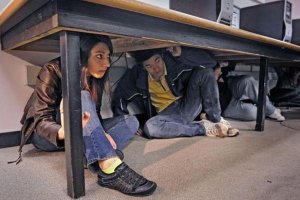Earthquake Alerts
In the United States, an organization sponsors an Earthquake Alerts system that notifies individuals through a special service called the "Earthquake Notification Service" or "ENS".
There is a specialized information center that implements the use of a unique system that strives to deliver pertinent warnings and notices regarding potential and current situations related to earthquake activity within the United States of America as well as events in other areas of the world.
This information center is often referred to as "ANSS/NEIC". This stands for "Advanced National Seismic System/National Earthquake Information Center". According to past Earthquake Alerts issued by this center, individuals in the United States are typically able to receive word about earthquake activity in five minutes or less. Information pertaining to worldwide events is typically received in a half hour or less. Throughout this informative guide, you will gain an understanding of special alerts related to seismic activity.
In order to receive an earthquake alert relating to activity that is seismic in nature, you should go to the home page of the website of the "ENS" or "Earthquake Notification Service". You will be pleased to find that you are able to customize the warnings and basic information that you receive in numerous ways. First of all, you may specify your unique time zone and specify the magnitude notifications that you would like to receive. In order to initiate your subscription, you will need to register with the service and create an account. Once your account has been created, a confirmation message will be sent to your email address. The Earthquake Alert will contain a special code that you will be required to enter on your account page in order to successfully complete setting up alerts that will notify you in the event of an emergency related to earthquakes. If you live in a zone that is known to experience seismic related activity, or know someone that does, setting up alerts may prove to be highly beneficial when it comes to knowing what is going on, and where it is going on at.

It has been established that earthquakes are considered to be a natural hazard that has the potential to affect as many as eighty million individuals in the United States alone. As many as thirty nine of the states can be affected in one way or another by earthquakes. Naturally, when the ground moves, many complications may arise...the ground may actually open up, buildings may collapse, and activities similar in nature may arise. While the art of earthquake prediction is still being perfected, alerts pertaining to these natural disasters have been found to be highly beneficial in preventing injury and deaths from occurring.
- DROP to the ground; take COVER by getting under a sturdy table or other piece of furniture; and HOLD ON on until the shaking stops. If there isn't a table or desk near you, cover your face and head with your arms and crouch in an inside corner of the building.
- Stay away from glass, windows, outside doors and walls, and anything that could fall, such as lighting fixtures or furniture.
- Stay in bed if you are there when the earthquake strikes. Hold on and protect your head with a pillow, unless you are under a heavy light fixture that could fall. In that case, move to the nearest safe place.
- Use a doorway for shelter only if it is in close proximity to you and if you know it is a strongly supported, loadbearing doorway.
- Stay inside until shaking stops and it is safe to go outside. Research has shown that most injuries occur when people inside buildings attempt to move to a different location inside the building or try to leave.
- Be aware that the electricity may go out or the sprinkler systems or fire alarms may turn on.
- DO NOT use the elevators.
- If outdoors
- Move away from buildings, streetlights, and utility wires.
- Once in the open, stay there until the shaking stops. The greatest danger exists directly outside buildings, at exits, and alongside exterior walls. Many of the 120 fatalities from the 1933 Long Beach earthquake occurred when people ran outside of buildings only to be killed by falling debris from collapsing walls. Ground movement during an earthquake is seldom the direct cause of death or injury. Most earthquake-related casualties result from collapsing walls, flying glass, and falling objects.
- Stop as quickly as safety permits and stay in the vehicle. Avoid stopping near or under buildings, trees, overpasses, and utility wires.
- Proceed cautiously once the earthquake has stopped. Avoid roads, bridges, or ramps that might have been damaged by the earthquake.
- Do not light a match.
- Do not move about or kick up dust.
- Cover your mouth with a handkerchief or clothing.
- Tap on a pipe or wall so rescuers can locate you. Use a whistle if one is available.
- Shout only as a last resort. Shouting can cause you to inhale dangerous amounts of dust.
Ask you Earthquake Alerts and Home Alarm Questions HERE!
From Earthquake Alerts to Natural Disaster
Back to Home Alarms-to-Alert-You


